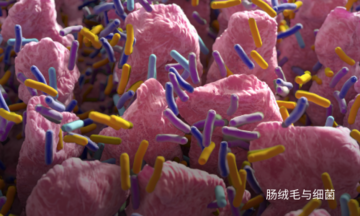以微生物组为中心的宠物健康状况干预

越来越多的证据表明,肠道微生物组有助于形成正常的神经发育、大脑生物化学和行为,而肠道菌群失调在焦虑、认知障碍和痴呆的发展或进展中起到了一定的作用。1
肠道微生物组可影响大脑功能和行为,而大脑反过来又通过双向沟通交流影响微生物组。“肠脑轴”一词是指胃肠道和大脑之间通过肠神经系统和迷走神经、交感神经系统、下丘脑垂体肾上腺轴、免疫系统以及微生物代谢产物进行的持续的双向沟通交流。1、2
通过营养干预改变微生物组有可能促进肠道和大脑之间的交流,并影响行为和情绪。2、3肠脑轴在调节喂食与葡萄糖稳态方面发挥着关键作用,2因此,在肥胖的发展过程中,它也起到了重要的作用。
将微生物组学理念付诸大脑健康实践

微生物组健康与认知健康紧密联系
理念
完整的微生物组和肠道屏障对维持健康的肠脑轴至关重要,肠道菌群失调和肠道屏障功能障碍与神经炎症有关。1、2
微生物组和肠道屏障受年龄影响,它们的变化在年龄相关的认知障碍和痴呆中起到了一定的作用。1、2

将理念付诸实践
肠道健康对大脑健康而言很重要,肠道菌群失调可能会增加罹患认知障碍的风险。因此,尽力维持和保护肠道微生物组健康对保护大脑健康和认知能力而言非常重要,尤其是老龄宠物。
益生菌有助于犬类保持平静
理念
慢性胃肠炎可能会引起类似焦虑的行为,益生菌长双歧杆菌 NCC3001 (BL999) 可通过肠脑轴发挥抗焦虑作用。3、4多达 70% 的犬行为障碍可归因于某种形式的焦虑。5兽医全科医生在鉴别和治疗患病宠物行为问题(如焦虑)方面的作用至关重要。6宠物主人可能不会识别出所有的恐惧和焦虑体征,或者可能只在问题升级到危象状态时才前往就医。7在一项盲法交叉研究中,当犬受到能够引发焦虑的刺激时,与它们补充安慰剂时相比,在补充长双歧杆菌 BL999 时,它们表现得没那么反应强烈(表现为皮质醇水平更低)、更平静(表现为平均心率更低)、情绪状态可能更好(表现为心率变异性增加)。此外,补充长双歧杆菌 BL999 时与补充安慰剂时相比,犬的某些焦虑行为明显减少。15

将理念付诸实践
益生菌菌株长双歧杆菌 NCC3001 (BL999) 可以减少焦虑行为,潜在改善情绪状态,并帮助犬类保持平静。

通过饮食改善犬特发性癫痫
理念
在人类和龋齿动物的研究中,微生物组是对生酮饮食产生反应的重要驱动因素。16-18
在患有难治性犬特发性癫痫的病犬中,中链甘油三酯生酮饮食显著降低了癫痫发作的频率,19减少了类似注意缺陷多动障碍 (ADHD) 的行为,20并改变了脂类的代谢。21

将理念付诸实践
中链甘油三酯 (MCT) 饮食为控制犬特发性癫痫提供了额外的工具,从而有机会通过微生物组和肠脑轴帮助控制癫痫。有关 MCT 的更多信息,请参阅我们网站的脑病部分。
探索Microbiome Forum的其他部分
了解更多信息
- Wu, M.-L., Yang, X.-Q., Xue, L. Duan, W., & Du, J.-R. (2021). Age-related cognitive decline is associated with microbiota-gut-brain axis disorders and neuroinflammation in mice. Behavioural Brain Research, 402, 113125. doi:10.1016/j.bbr.2021.113125
- Richards, P., Thornberry, N. A., & Pinto, S. (2021). The gut-brain axis: Identification of new therapeutic approaches for Type 2 diabetes, obesity, and related disorders. Molecular Metabolism, 46, 101175. doi:10.1016/j.molmet.2021.101175
- Bercik, P., Verdu, E. F., Foster, J. A., Macri, J., Potter, M., Huang, X.,…Collins, S. M. (2010). Chronic gastrointestinal inflammation induces anxiety-like behavior and alters central nervous system biochemistry in mice. Gastroenterology, 139, 2102–2112. doi:10.1053/j.gastro.2010.06.063
- Bercik, P., Park, A. J., Sinclair, D., Khoshdel, A., Lu, J., Huang, X.,…Verdu, E. F. (2011). The anxiolytic effect of Bifidobacterium longum NCC3001 involves vagal pathways for gut-brain communication. Neurogastroenterology & Motility, 23(12), 1132–1139. doi: 10.1111/j.1365-2982.2011.01796.x
- Beata, C., Beaumont-Graff, E., Diaz, C. Marion, M., Massal, N., Marlois, N., Muller, G., & Lefranc, C. (2007). Effects of alpha-casozepine (Zylkene) versus selegiline hydrochloride (Selgian, Anipryl) on anxiety disorders in dogs. Journal of Veterinary Behavior, 2, 175–183.
- Stelow, E. (2018).Diagnosing behavior problems: A guide for practitioners. Veterinary Clinics of North America, 48(3), 339–350. doi:10.1016/ j.cvsm.2017.12.003
- Ballantyne, K. C. (2018). Separation, confinement, or noises: what is scaring that dog? Veterinary Clinics of North America: Small Animal Practice, 48(3), 367–386. doi:10.1016/j.cvsm.20112.005
- Salman, M. D., Hutchison, J., Ruch-Gallie, R., Kogan, L., New, J. C., Kass, P. H., & Scarlett, J. M. (2000).Behavioral reasons for relinquishment of shelter dogs and cats to 12 shelters.Journal of Applied Animal Welfare Science, 3(2), 93–106.
- Tanaka, A., Wagner, D. C., Kass, P. H., & Hurley, K. F..(2012).Associations among weight loss, stress, and upper respiratory tract infection in shelter cats. Journal of the American Veterinary Medical Association, 240(5), 570–576. doi:10.2460/javma.240.5.570
- Landsberg, G., Hunthausen, W., & Ackerman, L. (2013).Behavior Problems of the Dog & Cat.Great Britain: Saunders Elsevier. pp. 181–182.
- Mills, D., Karagiannis, C., & Zulch, H. (2014). Stress – Its effects on health and behavior: A guide for practitioners.Veterinary Clinics of North America: Small Animal Practice, 44, 525–541.
- Mariti, C., Gazzano, A., Moore, J. L., Baragli, P., Chelli, L., & Sighieri, C. (2012).Perception of dogs’ stress by their owners.Journal of Veterinary Behavior, 7(4), 213–219.
- Seibert, L. M., & Landsberg, G. M. (2008).Diagnosis and management of patients presenting with behavior problems.Veterinary Clinics of North America: Small Animal Practice, 38, 937–950.
- Patronek, G. J., & Dodman, N. H. (1999).Attitudes, procedures, and delivery of behavior services by veterinarians in small animal practice. Journal of the American Veterinary Medical Association, 215(11), 1606–1611
- McGowan, R. T. S., Barnett, H. R., Czarnecki-Maulden, G., Si, X., Perez-Camargo, G. & Martin, F. Tapping into those ‘gut feelings’: Impact of BL999 (Bifidobacterium longum) on anxiety in dogs. ACVB Veterinary Behavior Symposium; July 12, 2018; Denver, Colorado.
- Zarnowska, I. M. (2020). Therapeutic use of the ketogenic diet in refractory epilepsy: What we know and what still needs to be learned. Nutrients, 12, 2616. doi:10.3390/nu12992616
- Cabrera-Mulero, A., Tinahones, A., Bandera, B., Moreno-Indias, I., Macias-González, M., & Tinahones, F. J. (2019). Keto microbiota: A powerful contributor to host disease recovery. Reviews in Endocrine and Metabolic Disorders, 20(4):415–425. doi:10.1007/s11154-019-09518-8
- Ma, D., Wang, A. C., Parikh, I, Greene, S. J., Hoffman, J. D., Chlipala, G.,…Lin, A.-L. (2018). Ketogenic diet enhances neurovascular function with altered gut microbiome in young healthy mice. Scientific Repots, 8, 6670. doi:10.1038/s41598-018-25190-5
- Law, T.H., Davies, E.S., Pan, Y., Zanghi, B., Want, E., Volk, H.A. (2015).A randomised trial of a medium-chain TAG diet as treatment for dogs with idiopathic epilepsy.British Journal of Nutrition, 114, 1438–1447. doi:10.1017/S000711451500313X Erratum in: British Journal of Nutrition, 2016; 115:1696.
- Packer, R. M. A., Law, T.H., Davies, E., Zanghi, B. M., Pan, Y., & Volk., H. A. (2016). Effects of a ketogenic diet on ADHD-like behavior in dogs with idiopathic epilepsy. Epilepsy & Behavior, 55, 62–68. doi: 10.1016/j.yebeh.2015.11.014
- Law, T. H., Volk, H. A., Pan, Y., Zanghi, B., & Want, E. J. (2018). Metabolic perturbations associated with the consumption of a ketogenic medium- chain TAG diet in dogs with epilepsy. British Journal of Nutrition, 13, 1–7. doi:10.1017/S0007114518001617


